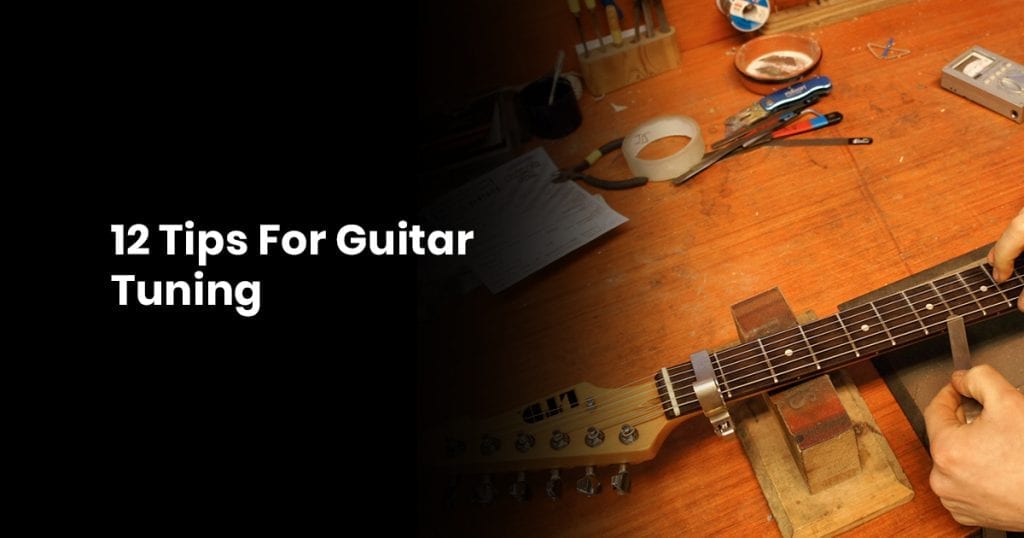Tuning your guitar is the number one essential skill to ensure that your instrument produces sweet music.
It is also the starting point to discovering if there are any problems with the workings of the guitar.
In this article, we’ll uncover the 12 top tips to ensure that tuning your guitar is a painless process.
Contents
#1 Invest in an Electronic Tuner
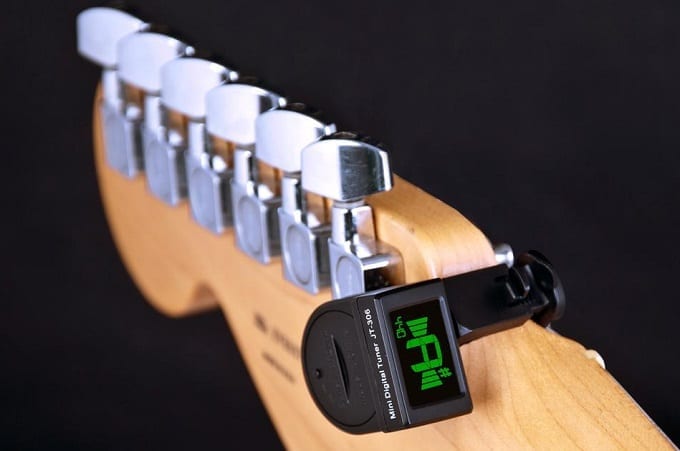
Electronic tuners have a fitted microphone which picks up the sound made by the strings when they are plucked.
Often they have a jack input so that you can plug your electric guitar directly into it.
You should invest in an electronic tuner with a jack input as it will allow you to tune the guitar anywhere because the tuner will only pick up the noise made by the guitar.
If you are a performer, you should look for an electronic tuner that has a jack output.
This will allow you to connect the tuner to your amplifier and will have a mute footswitch.
The footswitch will allow you to cut the signal to the amplifier while you’re tuning so that the audience can’t hear the twangs of odd strings as you’re tuning your instrument.
#2 Learn to Tune by Ear
Even if you have an electronic tuner, it is still advantageous to develop the skill of tuning by ear.
It will give you an appreciation of the pitch of various notes and can. This can eventually help you to play the guitar by ear.
You’ll also able to tune the guitar to itself, which means that you can tune in even if you have no reference pitch.
#3 Learn to Identify the Pitch of Notes

Some people have the innate ability to identify any note that is played to them.
This is known as perfect pitch.
Most people do not have this ability, with many considering themselves to be ‘tone-deaf.’
If you consider yourself to be in this category, you should try to identify the differences between notes.
Practice listening to notes that are sharp, flat and the same and appreciate the differences so that you can easily identify them.
Ask another person to play the notes in a random way so that you can test yourself.
#4 Compare Notes That Are Played Together
Learn to identify the way that notes interact when played together.
Listen to two identical notes that are played at the same time from two different guitars.
Compare this with the situation of when one guitar plays an A flat note and the other plays an A open note.
When you compare this with the two identical notes you should identify a real difference in how the notes mix together.
Do this with different notes to get an ear for the sound of different notes.
#5 Identify the Changes when You Turn the Tuning Peg
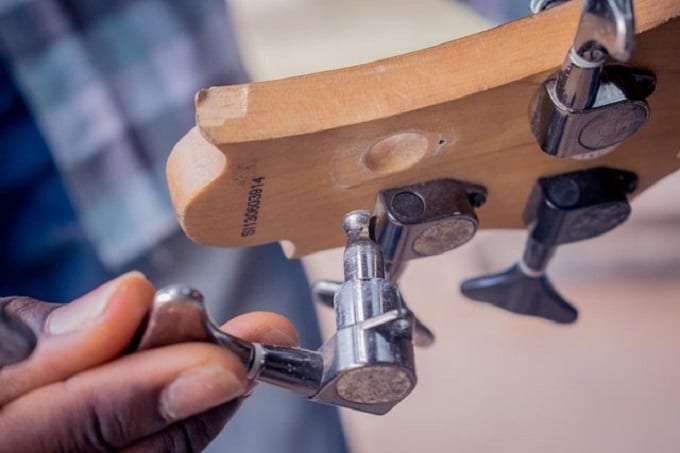
With the above example of two guitars, one playing an A flat and an A open note, slowly tighten the tuning peg on the A flat note.
You will hear that, as the notes continue to interact, the beats get further apart. As you tighten the tuning peg, the notes will get nearer to the same.
The combined sound will swell and produce a swirling sound. When the two sounds are perfectly in tune the swirling will stop.
#6 Tune an Open String from One Guitar to Another
Us the same process as in Tip#5 to tune an open string.
The string you are trying to tune should be flatter than the reference guitar string. Slowly turn the tuning peg to tighten the string.
Identify the beats and notice how they go from fast to slow and then disappear when the notes are perfectly aligned.
#7 Start with the String Flatter than What You Want
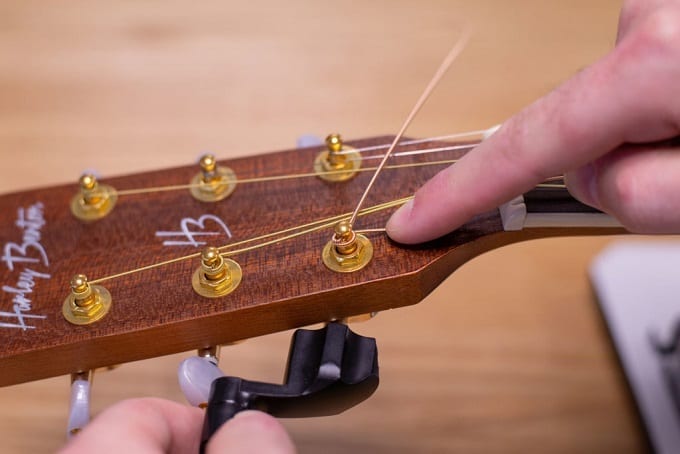
You should always start with the trying flatter than the note you are wanting to tune it to.
Turn the tuning peg to tune it so that the string becomes tighter as you bring it to the desired level. This ensures that the windings are tight with no slack.
If you were to start from a higher note and tune down, the string could contain slackness that gets released when you’re playing the guitar.
This could cause the string to get caught on the tuning peg, bridge, tailpiece or nut.
#8 NEVER Tune Down
Following on from the last tip, if you happen to over-tune the guitar and the string ends up too sharp, you should detune the string to get it back to flat and then start over again.
This will prevent the possibility of string slackness.
#9 Tune Your Guitar to Your Piano

If you have access to a piano, you can tune your guitar to it.
Tune your guitar to match the string sound to the matching sound on the piano. Start with the E note on the piano and then play the sixth string on the guitar.
Turn the tuning peg until the string sounds just like the note. Continue with each string.
#10 Use a Tuning Fork
A tuning fork has a pair of prongs and a stem to form a U shape.
It is usually made of steel. The standard fork produces an A note when struck against a hard surface.
To use the fork, hold it by the stem and strike it against your knee. Now place the stem on the body of your guitar.
Tune the string to match the sound that comes from the guitar.
# 11 Use Relative Tuning
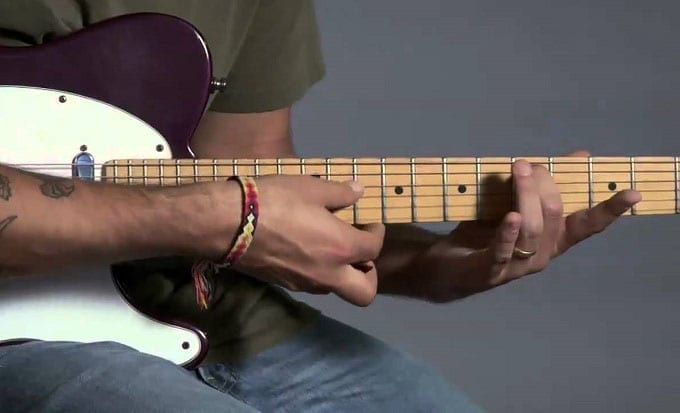
With relative tuning, you compare the sound and pitch of adjacent strings.
The higher-pitched string is tuned to match the sound of the lower string. This method assumes that the lower-pitched string is properly tuned.
Begin with the sixth string, which should have been tuned with a tuning fork or piano.
Pick the sixth string at the fifth fret and pick the string. Now tune the fifth string to match that sound (the sixth string’s fifth fret).
Once the fifth string is tuned, move to the fourth string. Continue down until each string is tuned to the fifth fret of the one before.
#12 The Best Guitar Tuner
There is a range of types of guitar tuners on the market.
The answer to the question ‘what kind of guitar tuner is the best’ is the one that gives you the highest level of sonic accuracy.
There are two main types of tuners:
- Tuners that plug into the guitar
- Tuners that do not a plugin
Compact battery-powered plug-in tuners are great for performers as they can be carried with you in the guitar and used anywhere, anytime.
Plugin tuners will provide a far more accurate sonic feedback as it cuts out all background noise.
Check out our Buyers Guide to find the best guitar tuners on the current market.
Conclusion
Guitar tuning is an essential skill for any player.
Thanks to the modern tuning tools that are available, it is not a hard process to accomplish.
However, it will require some time to attune your ear to identify the sound of the different notes.
Follow our dozen tips and you’ll soon be turning your guitar with ease.

